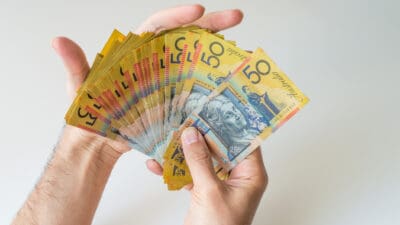Plenty of Australians begin their investing journey with the aim of building passive income. Receiving a regular income with little to no effort is obviously an appealing prospect.
But it often doesn't come cheap. Many ways to build a passive income, like buying an investment property or starting a business, typically carry notable upfront costs.
Fortunately, ASX dividend shares can also deliver attractive passive income. And investing on the stock market doesn't demand mountains of cash.
In fact, I believe I could build a portfolio capable of providing lifelong passive income with just $5 a day.
How I'd build lifelong passive income with just $5 a day
Taking the first step
The first step to building an income from ASX dividends is buying shares capable of paying them.
Plenty of stocks provide investors with a portion of their spare cash in the form of dividends. These are typically paid every six months and often come with franking credits, which can provide tax benefits.
However, buying shares generally incurs brokerage fees. These fees can really add up when regularly buying small parcels of stocks.
For that reason, I'd start by putting my daily $5 into a high-interest savings account until I build a sum large enough to invest. After a year, I'd have deposited $1,825 – more than enough to start building my portfolio.
Right now, the SPDR S&P/ASX 200 (ASX: STW) – an exchange-traded fund (ETF) that aims to mimic the S&P/ASX 200 Index (ASX: XJO) – offers a 4.74% dividend yield.
I think that I could beat that by strategically selecting stocks capable of offering a 6% annual dividend yield.
Building passive income by compounding
But there's more to my lifelong passive income plan than just buying ASX dividend shares.
For the first year after I invested $1,825, I would realise just $109.50 of passive income. That's certainly not enough to support my lifestyle.
So, rather than spend it, I'd add it back into my savings account and use it to buy more shares later.
By repeating that process, I'd compound my earnings. Here's how it would play out over the long term (without considering share price appreciation):
| Year | Portfolio value | Passive income (at 6% yield) |
| 1 | $1,825 | $109.50 |
| 5 | $12,730 | $763.80 |
| 10 | $27,323 | $1,639.38 |
| 20 | $72,987 | $4379.22 |
| 30 | $154,763 | $9,285.78 |
| 40 | $301,212 | $18,072.72 |
| 50 | $563,480 | $33,808.80 |
Of course, if my shares were also to rise in value over that time – and the market has historically always gone up – I would realise even more passive income.
Risk vs reward
But, like any other investment, ASX dividend shares come with risk. Companies don't have to provide dividends to investors, nor are shares guaranteed to appreciate.
Further, the market has always operated in cycles, meaning it's likely to crash at some point (or multiple points) over the coming decades.
Fortunately, such downfalls have always proven temporary. Though, they can dint the value of — and the passive income provided by — an investor's portfolio in the short term.
While many risks are unavoidable, an investor might choose to better protect themselves by buying safer shares – such as blue chips. They can also mitigate risk by building a diverse portfolio.









